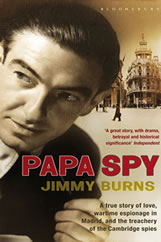I am delighted that my latest book A Faithful Spy ,on the life and times of MI6 and MI5 officer Walter Bell is being published this autumn . (published by Chisebury October 1 , available in bookshops and amazon.)
When Bell died in January 2004, aged ninety-four, the details of his life – not least of his professional career in the British secret services during a defining period in the history of modern espionage and security – remained a well-kept secret. He had been decorated with the US Medal of Freedom in 1947 for wartime services in support of the Allied cause and, close to his retirement in 1967, was appointed Companion to the Order of St Michael and St George (CMG), an honour reserved for those who make a significant contribution to the national interest. And yet, while providing some tantalising clues to an unusual and interesting career, an obituary in the London Times barely skimmed the surface of Bell’s story.
Descended from the founder of one of journalism’s pioneering newspapers, the News of the World, Bell was the wayward child of an Anglican vicar and his artist wife, born into Edwardian England and spending his private school days in the run-up to World War One rebelling against his background.
His student and early adult years saw him embrace left-wing politics, while developing a network of influential mentors, thanks to whom he was recruited by MI6 in the mid-1930s.
Bell went on to inhabit the shadowlands of secret intelligence straddling the Atlantic during World War Two before serving in the UK embassy, Washington, during a critical period in the post-war Anglo-American relationship. There were subsequent postings in Kenya, India and the Caribbean, where he keenly observed the challenging politics of the twilight of the British Empire. Since these were largely covert assignments, his high-level contacts with key historic figures such as FBI director J. Edgar Hoover, UK wartime MI6 chief in the US, Bill Stephenson, the Russian spies Donald Maclean and Kim Philby, British spy chiefs Dick White and Roger Hollis, and post-colonial independence leaders, Kenya’s Jomo Kenyatta, India’s Jawaharlal Nehru, and Guyanese Cheddi Jagan have remained both undiscovered and undisclosed. Until now.
Bell’s story would have remained untold had his American widow, Katharine (‘Tattie’) Spaatz – daughter of Carl Spaatz, the World War Two US general and commander of Strategic Air Forces in Europe, not passed on to the author of this biography her late husband’s extensive private papers.
At this point I should disclose a personal friendship with Tattie and Walter Bell. Tattie trusted me, and my credentials as an author and journalist, enough to believe I would use the material responsibly and constructively. By illuminating Walter Bell’s life I would be adding to our understanding of the twentieth century and, with the passage of time (January 2024 marks the twentieth anniversary of Bell’s death), provide posthumous recognition of his contribution to intelligence history. His unique access to a small number of key figures who were at the heart of the spy world constitutes a unique personal record of some of the failures and successes Bell gained intimate knowledge of when serving On Her Majesty’s Secret Service (MI6) and In Defence of the Realm (MI5). Among other things, Bell’s papers reveal the strains between wartime British and US intelligence and the controversial nature and attitudes of key political, diplomatic and covert players over more than three decades that defined the geopolitics of the twentieth century.
It is Bell’s extensive cache of papers – notes, memoirs, and correspondence with family, friends and sources, including revealing exchanges with controversial spies and leading government figures – that form the backbone of the narrative in the following pages. They provide a unique perspective of the key events that defined British international relations from the 1930s to the end of empire and the Cold War and the cast of characters involved as he experienced them at first hand. The personal detail and comment these papers contain bring to life a very human story, the fascinating less-than-ordinary story of a man who inhabited the world of discreet diplomacy, and secret intelligence, his life and times.

